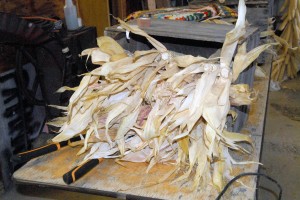Those within my tribe are much more aware of how dangerous processed food has become over the years. The tribe strives to eat organic food from the land that is not as processed. It is this dedication to quality that drives their celebrations of food, in which they show respect and give thanks to the land for providing them with healthy sustenance.
Today Oneidans have a hard time with diabetes and heart health because we’re not used to processing it genetically. I was always aware that Natives had health issues, but I never understood that our diet affected us more than overeating.
It stunned me to learn that this genetic factor also influences how Natives digest alcohol. Wilson told me that all drugs, including alcohol, translate as “mind-changers” in the Oneida language. Manthe explained that we can’t process alcohol the same way as European descendants, and it stays in our system longer. I discovered a study by Dr. Ting-Kai Li of Indiana University where findings concluded that Native Americans lack genes that protect against heavy drinking.
Of course, I grew up in a household being told you are what you eat, but learning how the way my ancestors lived currently affects me is an idea I had never considered. My aunt is always reminding me that my ancestors stand behind me and walk with me wherever I go. Still, this was the most concrete thing I have experienced to make me feel my ancestors are truly with me.

Photo by: Carrie Chesnik
Food in Action
Manthe shared with me a recipe for traditional corn soup, a popular dish on the reservation. In search of ingredients, I made my way to the Oneida store of the Tsyunhehkwa farm goods. Translating as “Life Sustenance,” the Oneida farm’s products demonstrate how crucial food is to their lives. All the food available in the store is produced on the nation’s farm, which is run by Director Jeff Metoxen. I was fortunate to spend the rest of my day on the reservation shadowing Metoxen as he took me around the farm and described its functions, goals and hopes for the future.
Starting off in the drying room where he showed me the art of braiding corn, Jeff gave me a tour of the entire organic-certified operation. The Oneidan farm offers vegetables, herbs, beef, chicken and corn, along with educational lessons. “We can’t feed everyone here,” says Metoxen. “And we don’t want to. But we can inspire them to grow their own produce at home.” He also explains that part of their mission is to educate and encourage people to become more involved and aware of their nutrition.
Anyone who visits the farm gets put to work. It’s a completely hands-on experience. My first task was to braid corn. Testing my patience and dexterity, braiding was as unique an experience as it was difficult. I intently focused on the braiding pattern, intricately weaving each piece of the husk together. If it’s not tight enough though, Metoxen says, there’s no fixing it. You just have to start over. At first slightly frustrated, I realized his explanation reinforced the Oneidan concept of food I’d begun to learn. The land provides us the nutrition and sustenance we need to eat healthily, but we have to put in the work to prepare it.
Food from the Land
The celebration of food will always remain a strong connection to my Oneida heritage. But it is deeper than just giving thanks for what we eat. It is about understanding what you put in your body and why. Having knowledge of the food the land provides us, such as what is ripe or when it is in season, is a lesson the Oneida stress to learn how food strengthens them.
Corn is one of the three staples in the Oneida diet. From the sweet, musky scent of it to the crinkle of the cornhusks, it is an integral part of the tribe. Along with beans and squash, they are the foundation of an Oneidan lifestyle. As such, the people take every opportunity to give thanks to their Creator for supplying them with such nutrients. Referred to as the Three Sisters, corn, beans and squash are used in virtually every meal for Oneidans and are present in almost every celebration year-round.
It was news to me that the corn referred to by Oneidans is not the sweet corn on the cob you might think. It means the milk that comes out of a kernel of corn. Most importantly, the corn is from the ground and forms a symbiotic relationship with us. As my aunt says, “We are people of the land and must always remember that we are people of the land, children of the earth, and can never be separated from it.” Metoxen explains that it is this important connection to the earth seen in the celebration of food that drives the Tsyunhehkwa farm’s mission to inspire others to produce their own food.
In addition to the energetic and creative experience Metoxen gave me, I also picked up the white corn I needed to create the corn soup Manthe had suggested. I was more than excited to have a recipe with only three ingredients to cook. I might love cooking, but complex recipes for something I’ve never made or seen prepared aren’t really my forte. Knowing where the corn was planted and when it was harvested is one step toward integrating the culture into my everyday life as an Oneidan.
When I first met Wilson and Manthe and told them I was part Oneidan they answered at the same time, “Where is that teaspoon?” When I didn’t understand, Wilson explained that your blood quantum, or percentage, didn’t matter. You either are Oneidan, or you aren’t.
I know now that being Oneidan means that I have a responsibility to understand and be grateful for the food I eat. It will become as much a part of me as being Oneida is. Not a piece I can point out, but rather something inside of me that continues to grow. I’ve already taken the first step by opening the door, now I plan to take some time and look around.
Related Posts:
